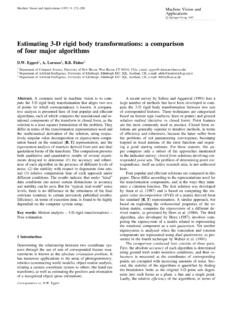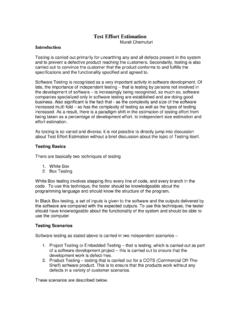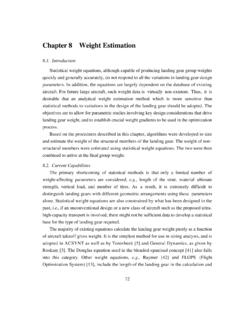Transcription of Stacked Hourglass Networks for Human Pose Estimation …
1 Stacked Hourglass Networks forHuman Pose EstimationAlejandro Newell, Kaiyu Yang, and Jia DengUniversity of Michigan, Ann work introduces a novel convolutional network archi-tecture for the task of Human pose Estimation . Features are processedacross all scales and consolidated to best capture the various spatial re-lationships associated with the body. We show how repeated bottom-up,top-down processing used in conjunction with intermediate supervisionis critical to improving the performance of the network. We refer to thearchitecture as a Stacked Hourglass network based on the successivesteps of pooling and upsampling that are done to produce a final set ofpredictions.
2 State-of-the-art results are achieved on the FLIC and MPII benchmarks outcompeting all recent : Human Pose EstimationFig. network for pose Estimation consists of multiple Stacked Hourglass moduleswhich allow for repeated bottom-up, top-down IntroductionA key step toward understanding people in images and video is accurate poseestimation. Given a single RGB image, we wish to determine the precise pixellocation of important keypoints of the body. Achieving an understanding of aperson s posture and limb articulation is useful for higher level tasks like ac-tion recognition, and also serves as a fundamental tool in fields such as Human -computer interaction and [ ] 26 Jul 20162 Newell et a well established problem in vision, pose Estimation has plagued re-searchers with a variety of formidable challenges over the years.
3 A good poseestimation system must be robust to occlusion and severe deformation, success-ful on rare and novel poses, and invariant to changes in appearance due to factorslike clothing and lighting. Early work tackles such difficulties using robust im-age features and sophisticated structured prediction [1 9]: the former is usedto produce local interpretations, whereas the latter is used to infer a globallyconsistent conventional pipeline, however, has been greatly reshaped by convolu-tional neural Networks (ConvNets) [10 14], a main driver behind an explosiverise in performance across many computer vision tasks. Recent pose estimationsystems [15 20] have universally adopted ConvNets as their main building block,largely replacing hand-crafted features and graphical models; this strategy hasyielded drastic improvements on standard benchmarks [1, 21, 22].
4 We continue along this trajectory and introduce a novel Stacked Hourglass network design for predicting Human pose. The network captures and consoli-dates information across all scales of the image. We refer to the design as anhourglass based on our visualization of the steps of pooling and subsequent up-sampling used to get the final output of the network. Like many convolutionalapproaches that produce pixel-wise outputs, the Hourglass network pools downto a very low resolution, then upsamples and combines features across multipleresolutions [15, 23]. On the other hand, the Hourglass differs from prior designsprimarily in its more symmetric expand on a single Hourglass by consecutively placing multiple hourglassmodules together end-to-end.
5 This allows for repeated bottom-up, top-down in-ference across scales. In conjunction with the use of intermediate supervision,repeated bidirectional inference is critical to the network s final final network architecture achieves a significant improvement on the state-of-the-art for two standard pose Estimation benchmarks (FLIC [1] and MPIIH uman Pose [21]). On MPII there is over a 2% average accuracy improvementacross all joints, with as much as a 4-5% improvement on more difficult jointslike the knees and Related WorkWith the introduction of DeepPose by Toshev et al. [24], research on humanpose Estimation began the shift from classic approaches [1 9] to deep et al.
6 Use their network to directly regress the x,y coordinates of work by Tompson et al. [15] instead generates heatmaps by running animage through multiple resolution banks in parallel to simultaneously capturefeatures at a variety of scales. Our network design largely builds off of their work,exploring how to capture information across scales and adapting their methodfor combining features across different is available ~alnewell/poseStacked Hourglass Networks for Human Pose Estimation3 Fig. output produced by our network. On the left we see the final poseestimate provided by the max activations across each heatmap. On the right we showsample heatmaps.
7 (From left to right: neck, left elbow, left wrist, right knee, rightankle)A critical feature of the method proposed by Tompson et al. [15] is the jointuse of a ConvNet and a graphical model. Their graphical model learns typicalspatial relationships between joints. Others have recently tackled this in similarways [17, 20, 25] with variations on how to approach unary score generation andpairwise comparison of adjacent joints. Chen et al. [25] cluster detections intotypical orientations so that when their classifier makes predictions additionalinformation is available indicating the likely location of a neighboring joint. Weachieve superior performance without the use of a graphical model or any explicitmodeling of the Human are several examples of methods making successive predictions for poseestimation.
8 Carreira et al. [19] use what they refer to as Iterative Error set of predictions is included with the input, and each pass through the networkfurther refines these predictions. Their method requires multi-stage training andthe weights are shared across each iteration. Wei et al. [18] build on the workof multi-stage pose machines [26] but now with the use of ConvNets for featureextraction. Given our use of intermediate supervision, our work is similar in spiritto these methods, but our building block (the Hourglass module) is different. Hu& Ramanan [27] have an architecture more similar to ours that can also be usedfor multiple stages of predictions, but their model ties weights in the bottom-upand top-down portions of computation as well as across et al.
9 Build on their work in [15] with a cascade to refine predic-tions. This serves to increase efficency and reduce memory usage of their methodwhile improving localization performance in the high precision range [16]. Oneconsideration is that for many failure cases a refinement of position within alocal window would not offer much improvement since error cases often con-sist of either occluded or misattributed limbs. For both situations, any furtherevaluation at a local scale will not improve the are variations to the pose Estimation problem which include the useof additional features such as depth or motion cues. [28 30] Also, there is themore challenging task of simultaneous annotation of multiple people [17, 31].
10 Inaddition, there is work like that of Oliveira et al. [32] that performs Human partsegmentation based on fully convolutional Networks [23]. Our work focuses solelyon the task of keypoint localization of a single person s pose from an RGB et illustration of a single Hourglass module. Each box in the figure corre-sponds to a residual module as seen in Figure 4. The number of features is consistentacross the whole Hourglass module before stacking is closely connected to fully convolu-tional Networks [23] and other designs that process spatial information at mul-tiple scales for dense prediction [15, 33 41]. Xie et al. [33] give a summary oftypical architectures.
![arXiv:0706.3639v1 [cs.AI] 25 Jun 2007](/cache/preview/4/1/3/9/3/1/4/b/thumb-4139314b93ef86b7b4c2d05ebcc88e46.jpg)

![arXiv:1301.3781v3 [cs.CL] 7 Sep 2013](/cache/preview/4/d/5/0/4/3/4/0/thumb-4d504340120163c0bdf3f4678d8d217f.jpg)
![@google.com arXiv:1609.03499v2 [cs.SD] 19 Sep 2016](/cache/preview/c/3/4/9/4/6/9/b/thumb-c349469b499107d21e221f2ac908f8b2.jpg)















